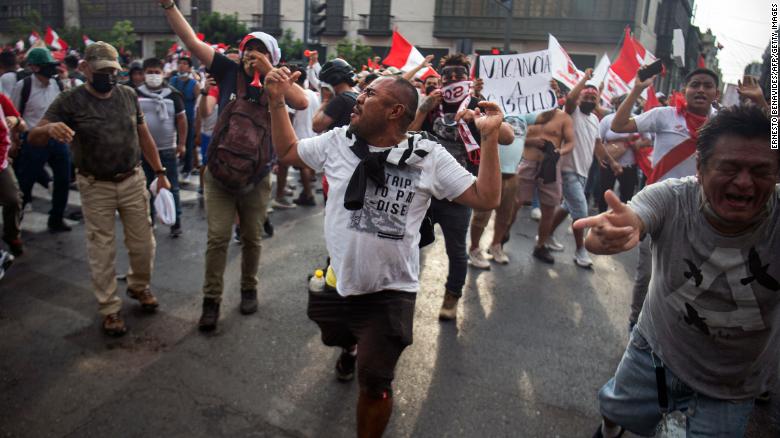Fewer protests in Lima but several blockades continue in Peru 5:24
(CNN) -
The intense wave of violent protests in Peru reveals how Russia's invasion of Ukraine is hitting markets around the world, sparking unrest and deepening political divisions.
Rising fuel prices initially sparked the protests last week, but the demonstrations quickly escalated into large anti-government demonstrations with marches and roadblocks.
Until this Wednesday, at least six people were reported dead during the days of protests, according to the Peruvian authorities.
Meanwhile, officials called for calm and struggled to contain the situation.
At least nine major highways in the country remained under blockades by protesters.
Castillo reverses the curfew: this is what we know about the situation in Peru
CNN crew was hit by tear gas in Peru 1:12
On Monday night, President Pedro Castillo declared a state of emergency and established a curfew in the capital.
However, the president backed down and withdrew the second measure on Tuesday afternoon, when hundreds of protesters ignored the order and took to the streets of Lima to demand his resignation.
"Peru is not going through a good time," Castillo said Tuesday as he left a meeting in Congress with legislators.
"But we have to solve it with the powers of the state," he added.
advertising
State of emergency in Peru: what can and cannot be done in Lima and Callao?
A few blocks away, riot police used tear gas to break up the protests and protesters threw stones.
At least 11 people were injured in the clashes.
Why Peru?
Political unrest is not something new in Peru.
Over the last five years, the country has had five presidents, of whom two were impeached and removed from office amid protests.
In fact, Castillo himself has already faced, and survived, two impeachment votes since he took office in July.
Last year, Castillo narrowly won the presidency and has faced a Congress held by the opposition.
This limits its political capital and its capacity to operate.
Police officers in Lima stand in front of a burning structure of street vendors during a demonstration against President Pedro Castillo.
The protests began over rising fuel and fertilizer prices in the wake of Russia's war in Ukraine, but have widened in scope.
Although Peru has been a fertile ground for protests in recent years, this crisis was triggered as a direct consequence of the war in Ukraine.
The Wider Consequences of Putin's War
Russia's invasion of Ukraine, and the ensuing decision by world leaders to isolate Moscow from the world's oil markets, caused the price of oil to skyrocket.
And, in the case of Peru, the impact has been especially serious.
Unlike other countries in the region, such as Argentina or Venezuela, Peru imports most of its oil.
That left it more exposed to the recent surge that hit the economy just as it was recovering from the impact of the pandemic and Covid-19 lockdowns.
The anger of the Peruvians: this is how the massive protests were experienced in Lima 3:35
As a result, Peru's inflation in March was the highest in 26 years, according to the country's National Institute of Statistics and Informatics.
The most exposed segment was food and fuel, with prices that rose 9.54% from last year, reported the Central Bank of Peru.
With prices rising rapidly, it wasn't long before protests began to spread across the country.
And on March 28, a group of transport workers and the truck drivers' union called a general strike to demand that gasoline be cheaper.
In recent days, other organizations and groups have joined the protests.
As a result of roadblocks and pickets, some regions closed schools and turned to online teaching as an alternative.
Before assuming the presidency, Castillo was a union leader and teacher in a small school in rural Cajamarca, which demanded better wages and working conditions.
Now his main constituents, the urban working class in the suburbs of Lima and rural farmers across the country, are being hit by spiraling inflation as they must pay higher prices for their food and transportation.
Demonstrators protest against the government of Prú President Pedro Castillo in Lima on Tuesday.
This further erodes their political support.
According to the Institute of Peruvian Studies, an independent center in Lima, the president's popularity is at its lowest point since he took office, with fewer than one in four Peruvians supporting his actions.
What's next?
It is difficult to predict how the situation will evolve.
Even before issuing the curfew, Castillo had already made some concessions to the protesters, cutting fuel taxes and raising the minimum wage to 1,025 soles, roughly $280, on Sunday.
But that also failed to quell the protests in the streets.
After his curfew order backfired, the president appears to be running out of options.
Precisely, Peru does not have the capacity to control the international price of oil.
As the conflict in Ukraine continues, the current inflationary climate is expected to spread.
Any additional subsidies to lower fuel prices would increase Peru's debts and further affect its ailing finances.
However, Peru's situation is far from unique and Castillo is not alone.
Other leaders face the same difficult decisions about how to manage rising inflation as they try to get their finances in order after the chaos caused by Covid-19.
As the crisis deepens, Peru could find itself looking to other countries for answers.
Claudia Rebaza, Jimena de la Quintana in Lima, Florencia Trucco and Jorge Engels, all of CNN, contributed to this story.
War in UkraineRussia invasion of UkraineProtests







